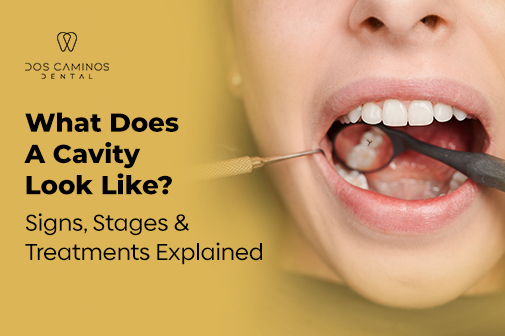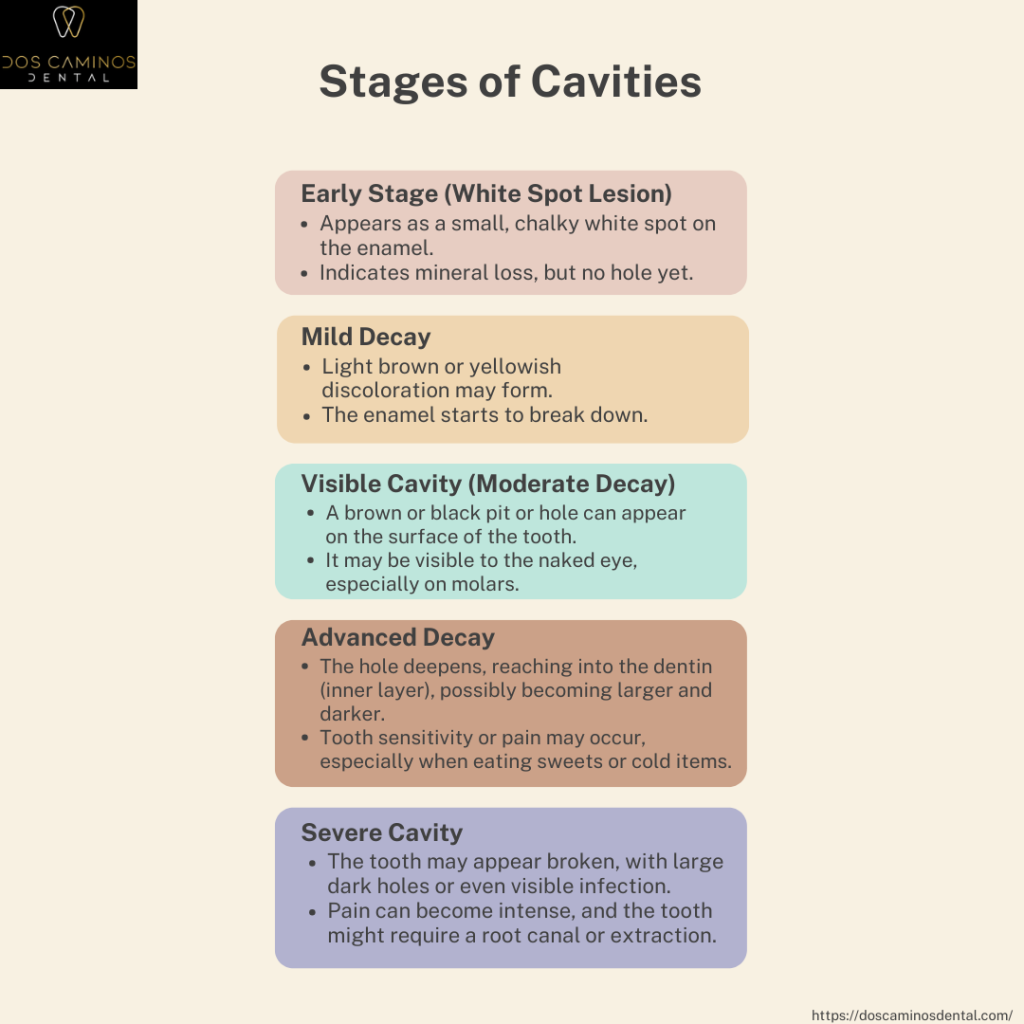
No one likes to hear the words “you have a cavity” from their dentist. In many cases, cavities can go unnoticed until the symptoms become too persistent to brush off.
Unfortunately, by that point, dental treatment is necessary. The best way to prevent this is by caring for your teeth regularly and paying attention to subtle changes before they escalate.
But, what does a cavity look like on a molar and how do you identify it, let’s dive in!
What Does a Cavity Look Like?
A cavity, also known as dental caries or tooth decay. It is a hole or area of damage in the tooth caused by bacteria. At the beginning, a cavity might just look like a white mark on your tooth. But over time, it can change color and become brown or black. You may also notice a small hole or dent in the tooth. Cavities usually happen in hard-to-clean areas, like between teeth or in the grooves of your molars. As the damage gets worse, you might feel pain or sensitivity when eating or drinking. Still, some cavities are hidden and don’t cause symptoms right away. For this reason, it’s a good idea to visit your dentist regularly so they can catch any problems early. Here’s how it typically looks and develops:

What Does a Small Cavity Look Like?
If you’re searching, ‘what does a cavity look like when it first starts’, here’s the answer.
A small cavity is the earliest visible sign of tooth decay and may not be immediately noticeable without a dental exam. As discussed above, it often begins as a white or chalky spot on the tooth, indicating early enamel demineralization. As it progresses, the area may develop a slight discoloration, appearing light brown or yellowish.
What Does the Start of a Cavity Look Like?
- Loss of Minerals: This happens when acids from plaque bacteria start breaking down the enamel.
- No Hole Yet: At this stage, there’s no actual hole—just a weakened area on the surface.
- Color Changes Over Time: If not treated, the white spot may turn light brown, gray, or even black.
- May Develop into a Pit: Eventually, the area can form a small hole or pit as the decay progresses.
- Usually No Pain Yet: In the early stage, cavities typically don’t cause pain or sensitivity.
- Reversible Stage: With proper brushing, flossing, fluoride use, and dental care, early cavities can often be stopped or reversed.
Causes of Cavities
Cavity is caused by a number of reasons stated below.
- Poor Oral Hygiene: Not brushing and flossing regularly allows plaque to build up and attack your enamel.
- Sugary and Starchy Foods: Frequent consumption of candy, soda, chips, and baked goods feeds harmful bacteria that produce acid.
- Plaque Buildup: Plaque is a sticky film of bacteria that forms on your teeth. If not removed, it hardens into tartar and leads to decay.
- Dry Mouth: Saliva helps wash away food particles and acids. A dry mouth increases the risk of cavities.
- Frequent Snacking: Constant snacking gives bacteria more time to produce acid that weakens tooth enamel.
- Not Getting Enough Fluoride: Fluoride strengthens enamel. Without it (through toothpaste or drinking water), teeth become more prone to decay.
- Deep Grooves and Cracks in Teeth: These hard-to-clean areas trap food and plaque, making them ideal spots for cavities to form.
- Acidic Drinks: Beverages like soda, fruit juices, and energy drinks can erode enamel and lead to cavities over time.
Treatments for Cavity
1. Fluoride Treatments
In the earliest stage of tooth decay, fluoride treatments can be very effective. These are usually applied by a dentist in the form of a gel, foam, rinse, or varnish. Fluoride helps to remineralize weakened enamel and can sometimes reverse early decay before it forms an actual cavity. Moreover, this treatment is painless and quick, making it a great preventive option if the decay is caught early. Regular use of fluoride toothpaste at home also supports enamel strength and protection between dental visits.
2. Dental Fillings
Once the decay has gone beyond the earliest stage and formed a hole in the tooth, a dental filling becomes necessary. During the procedure, the dentist removes the decayed portion and replaces it with a strong, durable material such as composite resin, amalgam, or porcelain. This way, the tooth’s function and structure are restored, and the spread of decay is halted.
3. Crowns
In cases where the cavity is too large for a regular filling, a dental crown may be the best option. First, the dentist removes the decayed part and reshapes the tooth. Then, a custom-made crown (often made from porcelain, ceramic, or metal) is placed over the entire tooth.
4. Root Canal Treatment
If the decay reaches the pulp of the tooth, a root canal treatment is required. At this stage, the dentist removes the infected tissue. Following this, a crown is usually placed to strengthen and protect the tooth. Despite common fears, modern root canals are much more comfortable than they used to be, and they allow patients to save their natural teeth rather than lose them.
5. Tooth Extraction
If a cavity has caused severe damage and the tooth cannot be saved, extraction becomes the only solution. In such cases, the dentist removes the tooth under local anesthesia. After the procedure, it’s often recommended to replace the missing tooth with an implant, bridge, or denture to maintain the alignment of your bite and jaw. Even though tooth loss can be concerning, replacing it promptly helps preserve both oral health and confidence.
Conclusion
Cavities can develop at any time—yes, even in young children. That’s why it’s essential for everyone, regardless of age, to stay on top of their oral hygiene. Taking preventive steps regularly can go a long way in protecting your smile.
If you notice signs of a cavity or suspect one, don’t wait—visit Dos Caminos Dental for a thorough checkup. Our friendly team is here to address your dental concerns and support your journey to optimal oral health.
Concerned about cavities or tooth pain? Don’t wait — reach out to Dos Caminos Dental for expert care and personalized solutions.
Contact Us 2438 N Ponderosa Dr, C-111, Camarillo, CA 93010
2438 N Ponderosa Dr, C-111, Camarillo, CA 93010





